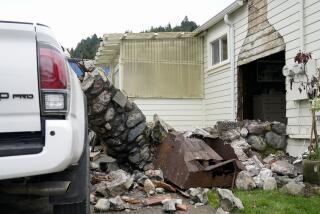Sensor Network Set Up to Try to Predict Lightning
- Share via
TULLAHOMA, Tenn. — Lightning remains a natural mystery, but scientists are using a national network to determine quick as a flash where the next bolt might strike.
The benefit, say these latter-day Ben Franklins, would lie in protecting computers, rockets and high-tech experiments. In the long term, a lightning monitoring network might one day predict the next strike and save lives.
“You wouldn’t believe how much juice is flying out there in just one day,” said U.S. Navy Capt. Peter Vanderwolf, secretary to the Working Group for Lightning Detection Systems, based at the Arnold Engineering Development Center, the Air Force research facility in this Tennessee town.
At least 68 people died from lightning strikes in 1986, and the national average is 97 deaths a year, according to the National Climate Data Center in Asheville, N.C.
A detection system would help scientists better understand lightning, the sky-splitting flashes caused by the discharge of atmospheric electricity from one cloud to another or between a cloud and the Earth.
The system also would have applications in aviation, communications, weather forecasting and power transmission.
Under the project, 75 antennae have been set up across the United States, with 25 more to be added by summer.
The 10-foot-tall sensors track lightning by monitoring electromagnetic energy, recording the strength of strikes, whether they are positively or negatively charged, and whether they are moving in one direction.
The antennas provide information to three regional lightning tracking systems, which form the national network.
Orville said the three systems, a West Coast network run by the U.S. Bureau of Land Management, a Midwest system owned by the National Severe Storms Laboratory and an extensive East Coast network operated from the State University of New York, are linked via telephone lines.
Since July 30, a central computer, in Albany, N.Y., has tracked all the lightning flashes in the coverage areas, recording each on magnetic tape, Orville said. The network has recorded more than 15 million flashes on tape.
The network tells scientists within seconds where lightning has hit, within two miles of the strike. But it does tell precisely where the next bolt will strike, although it will indicate which direction lightning is headed. And an educated guess is better than none, scientists say.
The Defense Department, the Department of Commerce, parent agency of the National Weather Service, and other federal agencies are working on the project.
“We can tell where lightning has hit within nine seconds of when it strikes,” said Richard Orville, chairman of the Atmospheric Studies Department at the State University of New York. “Now we can track storm systems over many hundreds of miles, whereas before you could only see them for 10 or 20 miles.”
More to Read
Sign up for Essential California
The most important California stories and recommendations in your inbox every morning.
You may occasionally receive promotional content from the Los Angeles Times.













